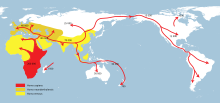Acheulian
 |
|
| Geographical range | Afro-Eurasia |
|---|---|
| Period | Lower Paleolithic |
| Dates | 1.76 million years BP – 100 thousand years BP |
| Type site | Saint-Acheul (Amiens) |
| Preceded by | Oldowan |
| Followed by | Clactonian, Micoquien |
| The Paleolithic |
|---|
|
↑ Pliocene (before Homo) |
|
Lower Paleolithic (c. 3.3 Ma – 300 ka)
(300–45 ka)
(50–10 ka)
|
| ↓ Mesolithic ↓ Stone Age |
↑ Pliocene (before Homo)
Acheulean (/əˈʃuːliən/; also Acheulian), from the French acheuléen, is an archaeological industry of stone tool manufacture characterized by distinctive oval and pear-shaped "hand-axes" associated with early humans. Acheulean tools were produced during the Lower Palaeolithic era across Africa and much of West Asia, South Asia, and Europe, and are typically found with Homo erectus remains. It is thought that Acheulean technologies first developed in Africa out of the more primitive Oldowan technology as long ago as 1.76 million years ago, by Homo habilis. Acheulean tools were the dominant technology for the vast majority of human history.
The type site for the Acheulean is Saint-Acheul, a suburb of Amiens, the capital of the Somme department in Picardy, where artifacts were found in 1859.
John Frere is generally credited as being the first to suggest a very ancient date for Acheulean hand-axes. In 1797, he sent two examples to the Royal Academy in London from Hoxne in Suffolk. He had found them in prehistoric lake deposits along with the bones of extinct animals and concluded that they were made by people "who had not the use of metals" and that they belonged to a "very ancient period indeed, even beyond the present world". His ideas were, however, ignored by his contemporaries, who subscribed to a pre-Darwinian view of human evolution.
...
Wikipedia
